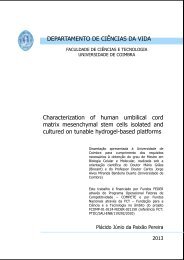Regulation of Apoptosis and Differentiation by p53 in Human ...
Regulation of Apoptosis and Differentiation by p53 in Human ...
Regulation of Apoptosis and Differentiation by p53 in Human ...
Create successful ePaper yourself
Turn your PDF publications into a flip-book with our unique Google optimized e-Paper software.
CHAPTER 1: Introduction<br />
1.1- HUMAN EMBRYONIC STEM CELLS<br />
The excitement <strong>and</strong> controversy surround<strong>in</strong>g the potential role <strong>of</strong> human embryonic<br />
stem cells <strong>in</strong> transplantation therapy have <strong>of</strong>ten overshadowed their potentially<br />
more important use as a basic research tool for underst<strong>and</strong><strong>in</strong>g the<br />
development <strong>and</strong> function <strong>of</strong> human tissue (Xu et al, 2002).<br />
<strong>Human</strong> embryonic stem cell l<strong>in</strong>es (hESC) are established from the <strong>in</strong>ner cell mass (ICM) <strong>of</strong> the<br />
blastocyst <strong>and</strong> differentiate <strong>in</strong>to all cell l<strong>in</strong>eages <strong>of</strong> the body (Figure 1.1). They were first derived<br />
<strong>in</strong> 1998 <strong>by</strong> James Thomson’s group <strong>in</strong> the University <strong>of</strong> Wiscons<strong>in</strong>-Madison, USA (Thomson et<br />
al., 1998) <strong>and</strong> have enormous potential as a source <strong>of</strong> cells for cell replacement therapies <strong>and</strong> as<br />
a model for early human development (H<strong>of</strong>fman <strong>and</strong> Carpenter, 2005). In fact, hESC represent a<br />
useful experimental system that provides access to stages <strong>of</strong> the human life cycle that were<br />
previously <strong>in</strong>accessible to experimentation (Pera <strong>and</strong> Trounson, 2004). Conversely, better<br />
underst<strong>and</strong><strong>in</strong>g <strong>of</strong> stem cell basic biology will help to improve ma<strong>in</strong>tenance <strong>and</strong> differentiation<br />
protocols for manipulat<strong>in</strong>g hESC, thus enabl<strong>in</strong>g the dissection <strong>of</strong> some developmental diseases<br />
<strong>and</strong> advancement <strong>of</strong> more effective treatments. Moreover, because hESC <strong>and</strong> their derivatives<br />
are diploid, they are more attractive than the transformed cell l<strong>in</strong>es for drug screen<strong>in</strong>g <strong>and</strong><br />
disease model<strong>in</strong>g.<br />
Two important features <strong>of</strong> embryonic stem cells (ESC) are their self-renewal capacity (they can<br />
be ma<strong>in</strong>ta<strong>in</strong>ed <strong>and</strong> exp<strong>and</strong>ed <strong>in</strong> culture) <strong>and</strong> pluripotency (they can differentiate to give rise to<br />
mesoderm, endoderm <strong>and</strong> ectoderm as well as germ cells). Unlike human embryonic carc<strong>in</strong>oma<br />
cell l<strong>in</strong>es (hECC, the transformed counterpart <strong>of</strong> hESC), hESC can conserve a normal karyotype<br />
if cultured under appropriate conditions.<br />
- 3 -
















